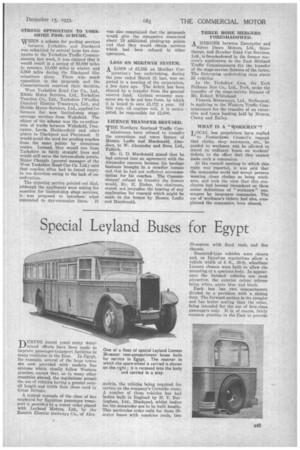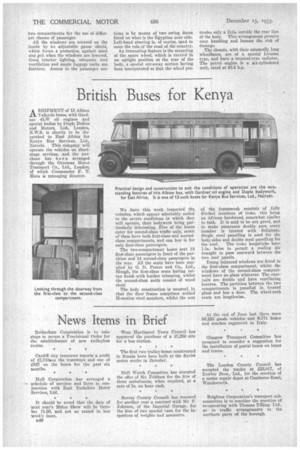Special Leyland Buses for Egypt
Page 63

Page 64

If you've noticed an error in this article please click here to report it so we can fix it.
DTIERING recent years many determined efforts have been made to improve passenger-transport facilities in many countries in the East. In Egypt, for example, several of the large towns are now provided with modern bus systems which closely follow Western practice, except that, as in many other countries abroad, the regulations permit the use of vehicles having a greater overall length and width than those used in Great Britain.
A typical example of the class of bus employed for Egyptian passenger transport is provided by a recent order placed with Leyland Motors, Ltd., by the Ramleh Electric Railways Co., of Alex audria, the vehicles being required for service on the company's Corniche route. A number of these vehicles has had bodies built in England by H. V. Burlingham, Ltd., Blackpool, whilst bodies for the remainder are to be built locally. This particular order calls for three 30seater buses with sunshine roofs, two
30-seaters with fixed roofs and five chassis.
Bonneted-type vehicles were .chosen and, as Egyptian regulations allow a vehicle width of 8 ft., 20-ft. wheelbase Lioness chassis were built to allow the mounting of a spacious body. In appearance the finished vehicles are most attractive, the exterior colour scheme being white, azure blue and black..
Each bus has two compartments divided . by a partition with a sliding door. The forward section is the roomier and has better seating than the other, being intended for the use of first-class passengers only. It is, of course, fairly common practice in the East to provide two compartments for the use of different classes of passenger.
All the windows are covered on the inside by an adjustable gauze shield, which forms a protection against sand and grit when the windows are lowered. Good interior lighting, adequate roof ventilation and ample luggage racks are features. Access to the passenger see
tions is by means of two swing doors fitted on what is the Egyptian near side. Left-hand steering is, of course, used to meet the rule of the road of the country.
An interesting feature is the mounting of the spare wheel, which is carried in an upright position at the rear of the body, a special cut-away section having been incorporated so that the wheel pro
trades only a little outside the rear line of the body. This arrangement permits easy handling and lessens the risk of damage. The chassis, with their unusually long wheelbases, are of a special Lioness type, and have a tropical-type radiator. The petrol engine is a six-cylindered unit, rated at 43.4 b.p.




































































































